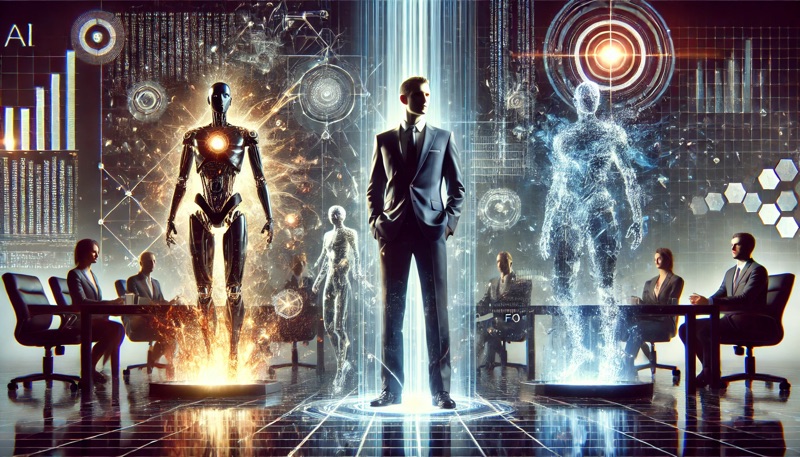AI and Leadership – Friend or Foe or just Misunderstood?
The other day, during a leadership meeting, one of my colleagues leaned over and whispered, half-jokingly:
“So, do you think ChatGPT is coming for your job too?”
I laughed. But later that evening, as I stared at the blinking cursor on my laptop, I thought—is it?
We’re living in a time where artificial intelligence isn’t science fiction anymore. It’s in our inboxes, in our recruitment platforms, in the dashboards we pore over, and sometimes (let’s admit it) in the witty responses we pass off as our own. It’s no longer a question of whether AI belongs in the workplace—it’s here. The real question is: in leadership, is AI a friend or a foe or simply misunderstood ?

The “Coffee Machine” Moment
When email was first introduced in my early career days, one leader I knew said, “This will kill conversations. No one will walk to the coffee machine anymore.” Fast-forward, and we know what happened: yes, email flooded our lives, but the coffee machine survived. We still needed human connection, and in fact, those who over-relied on email often missed the nuances, the relationships, the trust-building that leadership thrives on.
I see AI in the same light. If you treat it as a replacement for the very things that make you a leader—empathy, vision, judgment—then yes, it’s a foe. But if you use it like we now use email—a tool to clear the noise so you can focus on what really matters—it becomes a friend.
Leaders Aren’t Just Decision-Makers, They’re Storytellers
Winston Churchill once said, “Courage is what it takes to stand up and speak; courage is also what it takes to sit down and listen.”
AI can help leaders listen better. Imagine analyzing employee sentiment across thousands of survey comments. Ten years ago, it would’ve taken months of interns with red pens. Today, an AI tool can summarize themes in minutes. But here’s the kicker—AI won’t tell you how to stand in front of your team and acknowledge their concerns with authenticity. That’s the leader’s job.
In one recent town hall, I used AI to crunch workforce data and identify skill gaps. But when I stood in front of employees, I didn’t read out dashboards. I shared the story of how I too once felt left behind by a new technology early in my career—and how learning one new skill changed my trajectory. That mix of data and human story made the message land.

The Temptation to “Automate Leadership”
I once joked with my HR team: “What if we just asked AI to run our performance reviews?”
One colleague deadpanned, “At least it won’t cancel one-to-ones!”
We laughed, but here’s the truth—AI can process performance metrics, but it cannot replace the awkward, honest, and sometimes inspiring conversations between a manager and their team. Leadership is not about efficiency; it’s about humanity.
Where Trust Still Matters Most
The other day, an employee said to me after a leadership session, “I don’t need AI to tell me whether I belong here—I need my manager to show me.” That struck a chord. Algorithms can spot attrition risks or engagement dips, but they can’t sit across the table and say, “I see you. I value you.”
As Simon Sinek puts it, “Leadership is not about being in charge. It is about taking care of those in your charge.” AI can highlight who needs attention, but only leaders can give it in a way that builds trust.
My Perspective: Friend, If You Let It Be
Here’s where I land: AI is a powerful ally, but only if leaders resist the temptation to outsource their humanity.
- Let AI handle the heavy lifting of data, so you can spend more time with people.
- Let AI surface insights, but don’t forget to add context, empathy, and perspective.
- Let AI suggest options, but remember—it’s your judgment call that people follow.
Or as one of my mentors once told me: “A leader’s role is not to know all the answers, but to know which questions matter.”
AI may help you with answers, but the art of asking—and caring—remains very much human.
So, Friend or Foe?
I’d say: AI is like fire. If you’re careless, you get burned. If you’re thoughtful, you light the path.
And honestly, if one day AI does learn how to share an awkward joke at a town hall or sense when someone just needs a pat on the back, then maybe I’ll start worrying. Until then, I’m keeping my coffee machine chats—and my job.
Would you like me to tighten this for a 3–4 min LinkedIn read (snappier lines, scroll-friendly), or keep it slightly longer and more blog-magazine style like this?
Comments
Post a Comment